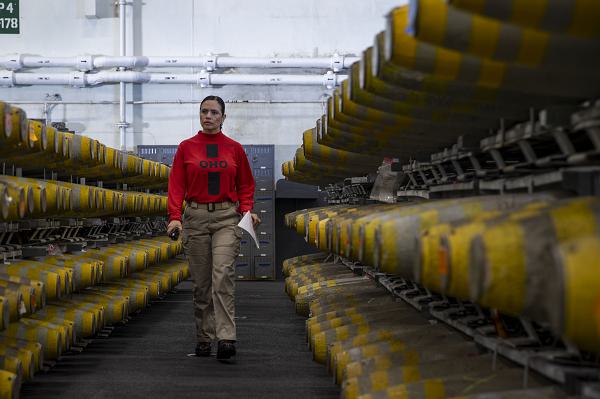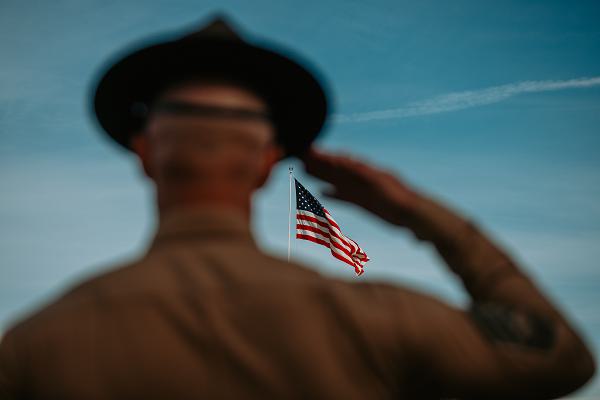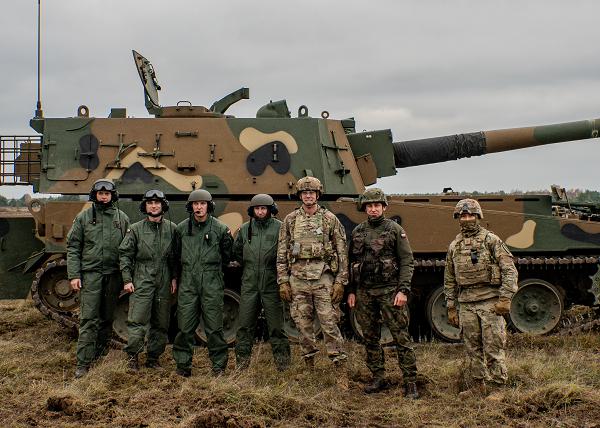- Details
- Hits: 2028

Pacific Ocean. (December 18, 2024): Their job is to transfer tons of high explosives, ship to ship, while underway at sea and it is dangerous business. In this photo by Seaman Malina Davy, Lieutenant Commander Maria Relayo inspects ammunition prepared for transport to the Nimitz-class aircraft carrier USS Abraham Lincoln. The ammunition is being delivered by the Lewis and Clark-class dry cargo ship USNS Washington Chambers, the Military Sealift Command’s newest class of dry cargo/ammunition ships.
In the Navy, ammunition is transferred to aircraft carriers primarily through a process called "underway replenishment". The at-sea replenishment concept began in the early 20th century and was used extensively by the U.S. Navy in the Pacific Theatre during World War II. The ability to replenish ship’s supplies while underway permitted U.S. carrier task forces to remain at sea indefinitely. A dedicated ammunition ship like the Washington sails alongside the carrier to perform either a “connected” or “vertical” replenishment of supplies.
Ammunition can be delivered by a "connected replenishment" method (side-by-side transfer) or a "vertical replenishment" using helicopters to deliver cargo directly to the carrier depending on the situation. Sailing alongside a carrier while transferring ammo between two moving vessels is challenging at best. Both ships must run side-by-side at precisely the same course and speed for a long period of time while managing volatile explosives.
- Details
- Hits: 2515

San Diego, California. (December 19, 2024): To many veterans, their basic training experience was the toughest on earth and many believe today’s standards are softer than those of previous generations. In this photo by Corporal Sarah M. Grawcock, Marine Corps Drill Instructor Sergeant Nicholas Marsh, with India Company, 3rd Recruit Training Battalion, instructs recruits before they are issued their rifles. Will these young troops experience a different type of Basic Training than their elders?
Absolutely. And for very good reasons.
First, the profile of Generation Z is quite different than previous generations. Born into the computer age, young folks today are better educated and more technically competent than any of their predecessors. Likewise, modern drill instructors have adapted their ways to reach this highly technical generation more effectively.
- Details
- Hits: 2212

San Diego, California. (December 19, 2024): It seems that nearly every military in the world has the custom, but what is the purpose of the salute? In this photo by Corporal Alexander O. Devereux, a Marine Corps drill master salutes the colors during a graduation ceremony at Marine Corps Recruit Depot San Diego. Every U.S. servicemember quickly learns how to properly render a salute and when and where to do it.
There is no definitive answer to the origin of the salute. The most common rumor dates the practice to medieval times when knights would raise their visors and display an open palm to show they were unarmed. The most likely explanation was a fundamental change in military headgear. In the English Army, for example, a junior Soldier would tip a hat to a superior which worked until the invention of the chin strap. From then on, it was impractical to remove one’s hat so the services adopted the simpler gesture of grasping the hat's visor which eventually morphed into today’s salute.
- Details
- Hits: 1480

Bastogne, Belgium. (December 14, 2024): In this photo by 1st Lieutenant Dalton Worley, Soldiers assigned to the 101st Airborne Division escort World War II veterans during a parade marking the 80th anniversary of Bastogne and the Battle of the Bulge. In their nineties now, this is likely the last chance to personally honor these members of the 101st Airborne Division (Air Assault) for its defense of the city and region from the German offensive during World War II. In the Battle of the Bulge, between December 16, 1944, and January 25, 1945, the United States suffered well over 80,000 casualties, including an official Army count of 19,246 dead and more than 23,000 American troops taken prisoner.
Perhaps suffering from a sense of overconfidence, most allied troops felt the war was practically “over in 44” and many even expected to be home for Christmas. Meanwhile, Hitler had other plans. The Further was secretly massing an attack force to launch a winter offensive through a weak point in the Allied lines in the Ardennes forest. The Nazi goal was to seize Antwerp, Belgium which would drive a wedge between the British army to the north from the American army in the south. Although Hitler did not expect this attack would win the war, he believed the Americans would be more likely to negotiate peace on favorable terms.
- Details
- Hits: 1164

Torun, Poland. (December 25, 2024): Like thousands of deployed U.S. servicemembers, the Soldiers with the 82nd Field Artillery Regiment will celebrate New Years with their host nation. In this photo by Sergeant Jacob Nunnenkamp, Lieutenant Colonel Douglas Mcdonough, 1st Battalion, 82nd Field Artillery Regiment commander, and his counterpart with the Polish Land Forces Major Alistair Fider pose for a family photo with Polish K9 artillerymen during the holidays.
The first thing American troops realize is that everyone does not celebrate the New Year like we do. In Poland, New Years Eve is called "Sylwester" and is celebrated with large, festive gatherings including dancing, fireworks, live music, and lots of food. In fact, food seems to be at the heart of most New Years welcoming’s and almost all are related to hopes for good luck.
In Poland, that food is the pickled herring which is believed to attract wealth. The fish’s shiny scales are thought to resemble coins hence the promise of financial success. Superstition holds that eating pickled herring at midnight is believed to bring a family good fortune in the coming year. Poles also consume opłatek, a kind of wafer, and make special meals that are supposed to bring good luck. During New Year’s Eve or Christmas Eve, people break this wafer with each other while offering good wishes.
- Details
- Hits: 1510
![]()
Bemowo Piskie Training Area, Poland. (December 15, 2024): There is a new hero on the battlefields of Ukraine, the U.S. Army M2A3 Bradley Fighting Vehicle. In this photo by Specialist Trevor Wilson, members of Charlie “Wildcards” Company, 2nd Battalion, 12th Regiment, 1st Armored Brigade Combat Team, 1st Cavalry Division drill with the Bradley and our Polish allies. The Bradley has gained iconic status among Ukrainian troops for its firepower, maneuverability, and safety.
Many Ukrainian soldiers have credited the Bradley with saving their lives.
Ukrainian troops have singled out the Bradley’s M242 Bushmaster 25 mm chain gun for its ability to conquer Russian armor. The chain gun fires up to three hundred rounds per minute and is accurate up to two miles. It is backed up by a 7.62 mm medium machine gun to the right of the chain gun for close up targets. The Bradley is also armed with a TOW missile launcher that carries two loaded missiles capable of destroying most tanks at over two miles.


